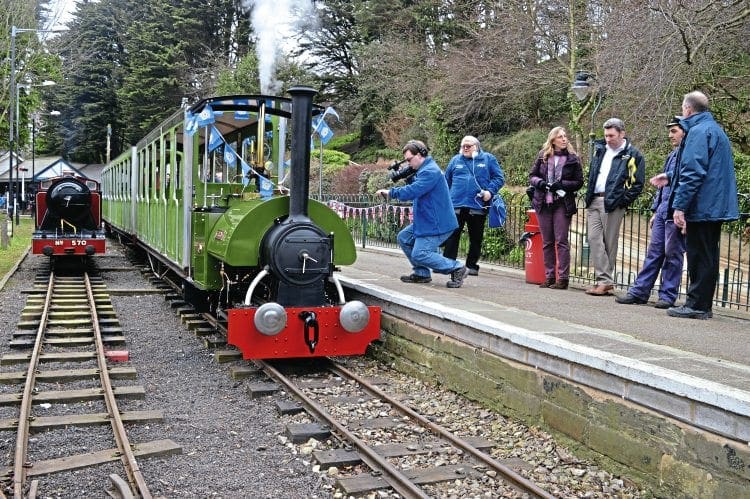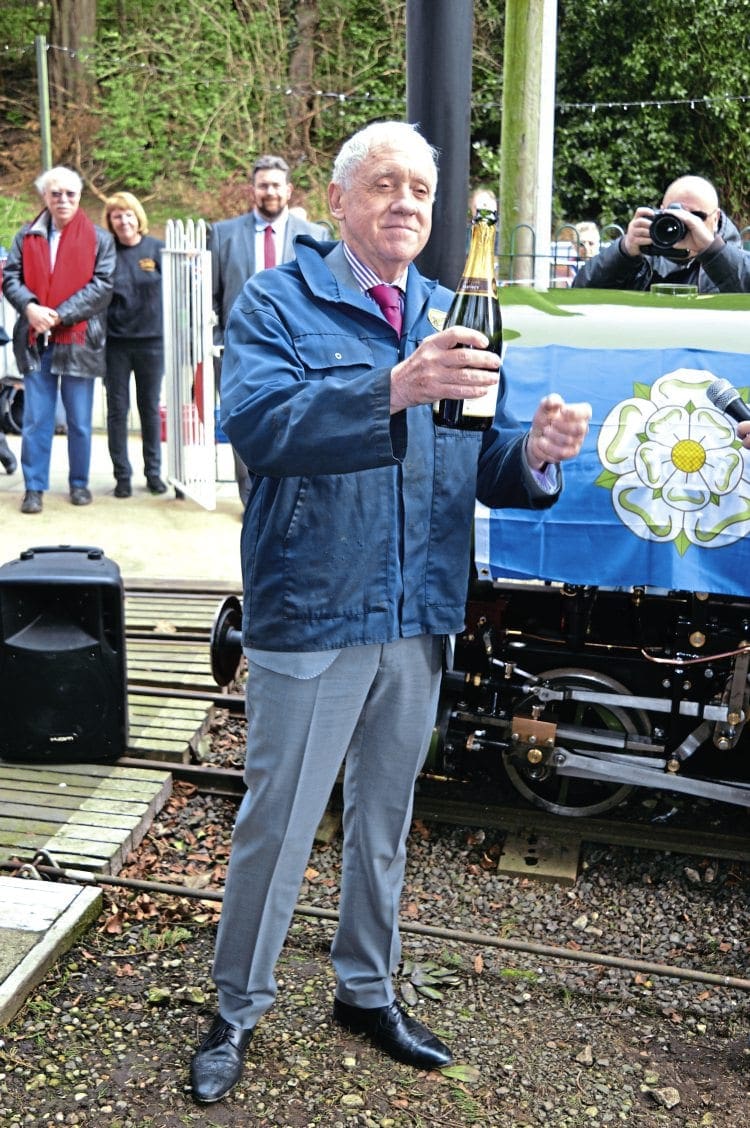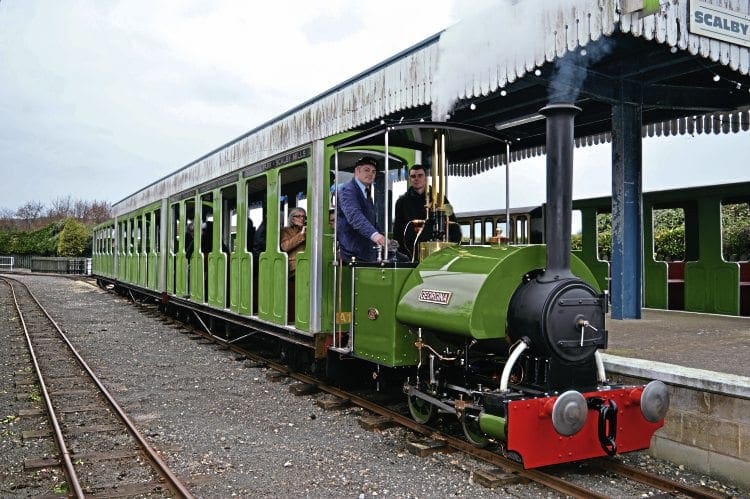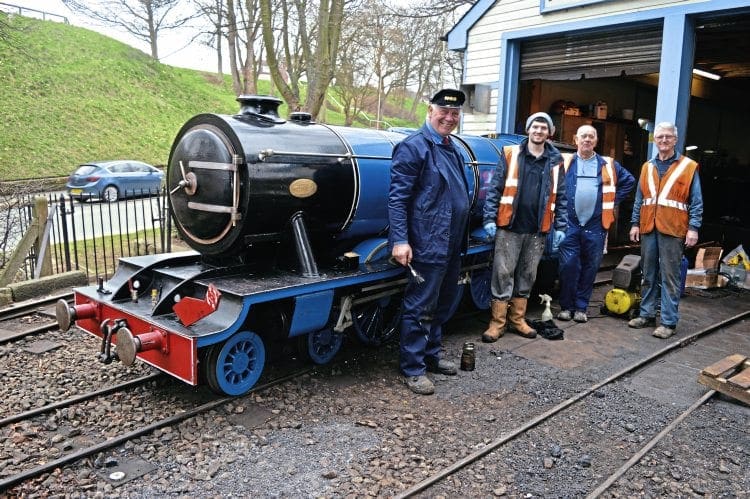Mark Smithers reports on the launch at Scarborough’s North Bay Railway of its first steam locomotive.
Billed in its 2010 souvenir brochure as ‘Britain’s biggest miniature railway’, Scarborough’s 20in-gauge North Bay Railway has constituted an important part of the town’s tourist industry for a period of more than eight decades. Unusual, but not unique in being constructed as a pleasure-orientated miniature railway with a gauge in excess of 15 inches, the line was opened in the presence of Alderman JW Butler, then Mayor of Scarborough on Saturday, May 23, 1931.

The route runs from a southern terminus at Peasholm Park, where the railway’s shop, booking facilities, sheds and workshops are situated, via the currently disused Beach station, a distance of about 1500 yards to the northern terminus at Scalby Mills.
The railway was operated by the local authority from its inception, except for a period of forced idleness from June 6, 1940 until Easter 1945, through to 2007, since when it has been operated by a new company, the North Bay Railway Co Ltd.
Enjoy more Heritage Railway Magazine reading every month.
Click here to subscribe & save.
The original locomotives used on the North Bay Railway were very much creations of the era in which they were constructed, and in order to understand how their design was arrived at, it is important to consider the effective choices facing the promoters of the railway before its opening. The original plan was to use 15in gauge, and to this end Bassett-Lowke tendered proposals for one of its classic miniature steam locomotive of that gauge. Baguley proposed either a steam or internal combustion locomotive of 2ft-gauge, and, given that the greater convenience and lower operating costs of the latter means of propulsion were readily apparent, what would probably have emerged is one of the company’s jackshaft-drive petrol-engined creations descended from its predecessor’s 10hp locomotives for the War Department Light Railways in the First World War
Hudswell, Clarke’s solution to the problem relied on 20in gauge and the then-new technology of diesel-hydraulic propulsion, employing a Dorman two-cylinder 26hp engine and torque converter transmission. Owing to the popularity of Sir Nigel Gresley’s LNER A1 Pacifics at the time, it was decided to give the new locomotive design an external resemblance to this class. Hudswell, Clarke’s tender for £1080 was accepted and on May 22, 1931 (the day before the opening ceremony) the NBR’s first locomotive, Neptune (works number D565), made the short journey from the Railway Foundry in Leeds to the railway that has been its home ever since.
Much-needed revenue
During the first season of operation, Neptune accumulated a mileage of 6210 and hauled 418,875 passengers, bringing the council £12,307 in much needed revenue. A second similar locomotive, Triton, left the Railway Foundry on April 29, 1932 and these two locomotives formed the mainstay of the line’s operational capability during the remainder of the council’s period in charge.
They are now both on their fifth engines (Kubotas), having received engine renewals by the makers in 1959 (Dorman 30hp DLIII) and 1967 (Perkins in conjunction with Brockhouse torque converters), while their Kubota engines were fitted in the late 1980s and apparently swapped over a few years later. Their transmission equipment has also been renewed again, now consisting of pumps and hydraulic motors.
Following the construction of Neptune and Triton, Hudswell, Clarke built other locomotives using the same principles, including a Baltic-outline locomotive Robin Hood (D570 of 1932) and another Gresley-inspired 4-6-2 May Thompson (D582 of 1933) for the 20in-gauge line at Golden Acre Park, Bramhope, near Leeds. These locomotives have had somewhat chequered careers, surviving the closure of the Golden Acre system in 1938, storage, a period of service at Morecambe, subsequent spells at Kilverstone Wildlife Park, Thetford, and at Woburn, prior to coming via the Cleethorpes Coast Light Railway to Scarborough in late 2006, in readiness for the ‘change of regime’.
As with the two original NBR locomotives, both of the ex-Golden Acre pair have lost their original engines as a consequence of rebuilding and May Thompson now bears the name Poseidon. No significant alteration has been made to these locomotives since acquisition by the North Bay Railway and currently Robin Hood is fitted with a Lister three-cylinder engine, while Poseidon has a Same Deutz-Fahr. Both currently have hydraulic transmissions.
Although the Hudswell diesels are very much identified with the North Bay Railway, the new operating company is capable of building new units and the desire for a true steam locomotive to run on the railway proved irresistible. It was not the first time that such a move had been envisaged as during the latter half of the 1940s, the council approached Hudswells with a view to obtaining such a locomotive. Unfortunately, locomotive reversal at Scalby Mills at this stage was accomplished by means of a balloon loop partly enclosed in a tunnel, rather than the present turntable, and the mere three-inch uppermost clearance would have prevented the use of a steam locomotive as a consequence of interference with its draughting.

Not politically acceptable
Had this difficulty not arisen, it is interesting to speculate what the Leeds manufacturer would have come up with as a locomotive design: Neptune’s specification could not easily have been adapted owing to its short ‘firebox’ area. The one Hudswell ‘diesel miniature’ specification that could possibly have been adapted for this purpose was the ‘LMS Princess’ type built to 21in gauge for Blackpool and Butlin’s but this might not have been politically acceptable on a miniature railway situated firmly in LNER territory!
Be all of this as it may, choosing a new steam locomotive design for a slim-gauge railway is a whole new ball game in the 21st century when compared to the 1940s. This is largely down to two seismic events in the 1960s: the loss of main line steam in ordinary revenue-earning service, and the rising level of interest in narrow gauge and industrial railways, as exemplified by the beginning of serious detailed study of the work of Sir Arthur Heywood.
In the spring of 2014, NBR Services Ltd. was set up as a subsidiary to the NBR with the intention of offering new-build and repair facilities to external customers. With respect to the former category, one design of locomotive that caught the attention of the owner/director was the tiny Bagnall Sipat type. This specification was the smallest of the standard ‘Bullhead’ Bagnall 0-4-0ST designs, being produced in three sizes: 10hp, 15hp and 20hp (all 7½in cylinder stroke, respectively 4in, 4½ in and 5in bore) weighing between 3¼ and 3¾ tons in working order. The original Sipat was Bagnall No. 1868 of January 1908 and was built to the smallest of these sizes, although the design (as with the better-known and larger Mercedes class) evolved from earlier classes dating back to the 1890s.
Relatives of these latter locomotives included the smallest variety of the Pekoe-Tip 0-4-2ST (of which examples survive in India, albeit shorn of their trailing trucks), and the Aird class with high-pitched domed conventional locomotive pattern boiler (a development of which, fitted with Walschaerts’ valve gear, was constructed after the Second World War for use in Turkey).
Returning to the mainstream Sipat specification, the Bagnall ‘Bullhead’ boiler has the advantage of relative ease of construction over the conventional pattern, albeit at the expense of longer steam-raising times when compared to the latter. The ‘proof of the pudding’ for most enthusiasts, however, will be the number of larger ‘6 in’ and ‘7 in’ ‘Bullhead’ locomotives in preservation today.
The ‘Bullhead’ pattern of boiler, introduced into Bagnall’s product strategy in 1893 (with No. 1416) by Ernest Baguley, appears to derive its inspiration from the ‘Britannia’ or ‘Colonial’-pattern cylindrical firebox boilers with enlarged fireboxes fitted to portable engines produced by Marshalls of Gainsborough, which in turn were preceded by a boiler of similar pattern constructed by at least one German manufacturer. The enlarged firebox and wrapper makes for a better relationship between the firebox dimensions and boiler barrel volume than the simple one-piece boiler barrel employed by Sir Arthur Heywood.

Early ancestor
The Sipat’s specification evolved from the early ancestor (the best-known of which was probably No. 1560 of 1899 of 18in gauge for Brede Waterworks in Sussex), a type normally characterised by a plain smokebox saddle and ‘modified Baguley’ valve gear (although the two surviving 1890s-built 2ft gauge Pekoe-Tip versions in India have the original Baguley variety) into the class proper which possessed a ribbed smokebox saddle and Bagnall-Price valve gear. The change from plain to ribbed smokebox came earlier in the evolutionary path than the move from ‘modified Baguley’ to Bagnall-Price valve gear as evidenced by 18in-gauge ancestor Ant (No. 1651 of 1902), which combined the later pattern smokebox with the earlier pattern valve gear.
The Sipat class was advertised in the maker’s catalogues as being suitable for gauges of between 18in and 3ft 6in and before producing the new-build version for external sale, it was decided that a 20in-gauge version would fit the bill for the North Bay Railway’s requirements. Construction work on Georgina, as the new locomotive was to be named, was started by the railway, being taken over by NBRES Ltd in 2014. By late November of that year, many components had been completed and the chassis was in the company’s workshop in readiness for finishing and compressed air trials.
One early boon to the project was the existence of a cylinder pattern, originally manufactured in Australia for a 2ft-gauge replica of New Zealand’s Bagnall 0-4-2T Annie (the original of which was Bagnall No. 1922 of 1911 built to 2ft 6in-gauge for Gisborne Borough Council’s Gentle Annie Tramways and whose remains are now preserved at New Zealand’s East Coast Museum of Technology at Makaraka, near Gisborne, having been exhumed from a quarry near Motuhora in the 1970s).
These were subsequently imported for use by Richard Booth in the Groudle Glen Railway’s own (more accurate, but still 2ft-gauge) replica of the same locomotive, completed in 1998, and the cylinders cast from them became available when the GGR decided to replace these items on its own Annie with a new pair. These are a closer match for those fitted to the original engine. Although this measure meant a small element of compromise in relation to the original Sipat design, it reduced construction time, and Georgina was largely mechanically complete by October 2015, when successful compressed air test on the chassis was carried out.
After this stage, the finishing touches were applied to the boiler, including the fitting of the ‘dry’ firebox backhead. By early December 2015, the cab waist sheets had been fitted and by the end of January most of the paintwork had been accomplished, but the smokebox front, chimney and saddle tank remained to be fitted. Georgina eventually undertook its first steam test on March 2, 2016 and its public launch took place at 11am on Wednesday, March 23.

Naming ceremony
There was a special audience of invited guests that included BBC Look North’s Harry Gration, the Mayor and Mayoress of Scarborough, Cllr Thomas Fox and his wife Ros, and well-known railway artist Jonathon Clay, who presented the railway with an original painting of Georgina. The naming ceremony for the locomotive was performed by Harry Gration and special trains for the guests, along with light engine driving experiences, took place throughout the day. Three of the line’s other four locomotives were also lined up at Peasholm Park station, with their ‘miniature’ outlines contrasting with Georgina’s functional narrow gauge proportions in a manner evoking the early Greenly/Heywood contrast on the Ravenglass & Eskdale Railway in a fashion most appropriate for the centenary year of Sir Arthur Heywood’s death.
Georgina is basically a modern-day incarnation of the mature form of Sipat, incorporating the strengthened smokebox saddle and Bagnall-Price valve gear. Certain refinements have been introduced that were not present in the original specification, including a mechanical lubricator and roller bearings for the axles. The ability of these latter components to reduce rolling resistance is very evident from the locomotive’s free- running properties. An interesting original feature that has been retained on the new-build locomotive is the wooden tank filler lid.
North Bay Engineering Services Ltd is currently engaged in several steam heritage-related projects, ranging from work on traction engines through to completion of a half-scale model of Sir Arthur Heywood’s Effie to the overhaul of a 2ft-gauge Hunslet 0-4-2T of Avonside design for the South Tynedale Railway. A 2ft gauge ‘Bullhead’ Bagnall locomotive, built on similar lines to Georgina, but with pannier tank styling similar to Annie and Baguley-built Rishra, is currently planned. This can be built with a chassis of either the Sipat or Pekoe-Tip design.
For further information, prospective customers for this or any other locomotive design should contact North Bay Railway Enfineering Services Ltd on 07831381333 or nbres.co.uk
More ‘From Our Archives’ Features can be found at www.heritagerailway.co.uk
Read more News and Features in Issue 230 of HR – on sale now!




